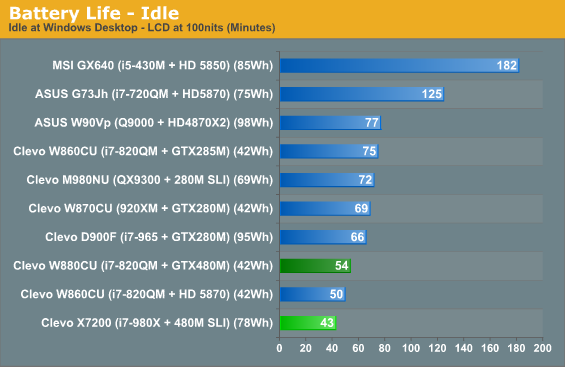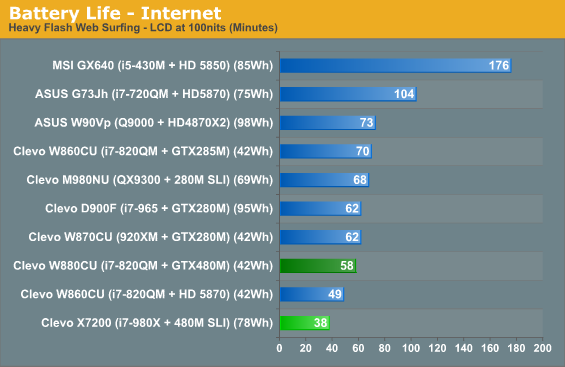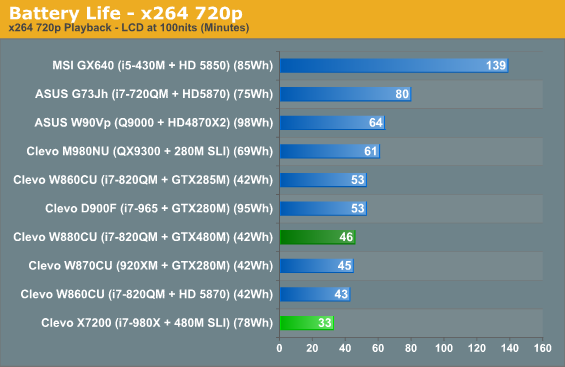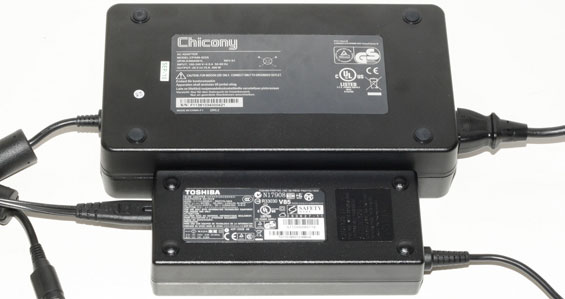AVADirect Clevo X7200: Six Cores, SSD RAID, and GTX 480M SLI Yields World's Fastest DTR Notebook
by Jarred Walton on October 7, 2010 12:30 AM ESTIntroducing the Clevo X7200 UPS
If you're after raw performance in a transportable notebook, clearly the Clevo X7200 can deliver. We've shattered every notebook benchmark in our test suite—hardly surprising since the system manages to keep pace with full size desktops! But some will inevitably ask, "What about battery life?" We ran our standard set of tests just for fun, because let's be honest: no one expects a DTR system to deliver great battery life, and when you start stuffing multiple GPUs and desktop CPUs into a notebook the battery life is laughable. Ready for the shortest battery life result we've ever measured?




Yes, we top out at a maximum battery life of 43 minutes—doing nothing beyond sitting at the desktop. We've set the CPU to 0% maximum (i.e. run at the minimum clock speed), the display is at 100nits (42% brightness), and the HDD/SSDs are set to power down after 1 minute of inactivity. So we're essentially looking at an integrated UPS (Uninterruptible Power Supply). Do some Internet surfing and battery life drops to 38 minutes, and we come up with just over a half hour of video playback time. Even the old D900F with a desktop i7-965 gets 33% more battery life per Wh, but then it only supports a single GPU. Similarly, the W880CU with a single 480M and a puny 42Wh battery bests the X7200. With .49 minutes per Wh, you’d have to carry around a massive 240Wh battery just to surf the Internet for a couple hours…but it would be great exercise!

If you're curious about the size of the power brick, that's a 120W power adapter from the Toshiba A665-3DV. It's relatively large compared to many bricks but dwarfed by the X7200 adapter! Dimensions on the Clevo power brick are 8.13" x 4.44" x 1.94" (L x W x H). We don't have a scale that's accurate for objects this size, but we'd estimate the weight at close to three pounds.










38 Comments
View All Comments
Wolfpup - Wednesday, October 13, 2010 - link
This article seems to imply that the G73jh/jw uses florescent backlighting, but it's LED, right?Wolfpup - Thursday, October 14, 2010 - link
Okay, I've been told the G73jh/w are LED backlit, so that's good.JarredWalton - Saturday, October 16, 2010 - link
The displays in all of these are the HannStar HSD173PUW1. To my eyes, it *looks* more like CCFL than LED, and the brightness levels are pretty weak (maximum of 180nits or so). I can't find any concrete details, but everyone else appears to thing it's LED backlighting so I might be wrong.JarredWalton - Saturday, October 16, 2010 - link
Update: notice the ASUS page:http://rog.asus.com/Product.aspx?PId=32#product_ta...
They simply list it as "17.3" Full HD (1920x1080)/HD+ (1600x900) Color-Shine (Glare-type)", which would be odd for an LED backlit display. Especially when the G60Vx explicitly states LED backlighting:
http://rog.asus.com/Product.aspx?PId=30#product_ta...
mikeev - Wednesday, October 20, 2010 - link
Why do you guys never mention the fingerprint sensors on these laptops? I know they're not the most exciting things in the world, but they're pretty nice feature additions. Beats typing in your password every time.Gonemad - Thursday, November 4, 2010 - link
Now, about the power brick... did Furmark just cause a 'thermal runaway' back there? 410W, are you kidding? That's nearly 40% overload on the nominal brick power, no wonder it cried for mommy and called it a day after some time of testing.It raises a couple of questions:
1) In the review itself, it is mentioned about other notebook that would actually drain the batteries when the PSU is topped-out. Clevo should go visit the same idea, now knowing that some extreme usage can compromise the PSU. Call it a 'feature'. Call it 'Overdrive' or whatever; it lets you have all the juice you need even overloading the PSU, but it detects the condition, light up a yellow warning light, and lets you do it for, say, 30 mins before cutting BACK, not OUT, the power drain. It doesn´t shut down, not completely. Again, the battery being used as a VOLTAGE STABILIZER looks good.
Well, then again, the benchmark was a deliberate attempt to overload the thing.
2) Aftermarket an even LARGER power brick, this time full-fledged 500W PSU at 4 pounds or higher. Considering everything else, it is not so preposterous.
3) If Anand dumped the original PSU, but kept it going on a LARGER DC source (a good and nice desktop PSU ought do it), how far would it go? Would something else drop out?
Classic Rock - Sunday, November 7, 2010 - link
I have read in the X7200 User forums that Clevo has offered a "Solution" of combining two PSU's together with some sort of adapter. There wasn't a lot of detail where I read it though. Does anyone know anything else about this? Does anyone know if it is possible to get an aftermarket PSU for this rig?Classic Rock - Sunday, November 7, 2010 - link
Adding to my previous post:http://www.nextcomputing.com/products/mobile-works...